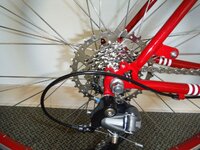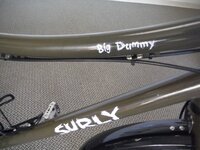m@Robertson
Merciless (on the inside)
- Region
- USA
For long term reliability, you want to have many things in order. Do your build right and you will have long life on your drivetrain without the issues a lot of people have. My Bullitt came into use in March, and just crossed 1000 miles. It has no sign of chain, chainring, cog or cassette body wear. It has an 11 spd drivetrain. My Surly Big Fat Dummy is a monster of a bike and it is about to cross 1500 miles since mid-July of 2020. Almost the same 11 spd drivetrain. Same deal with no signs of visible wear yet. That bike is a longtail and has two chains totalling somewhere around 210 links.
In addition to choosing the right hardware, chainring alignment is a HUGE deal to preventing the chain from buzz sawing through a chainring and cogs. You don't have as many options with an Ultra but you do still have some. In particular the Christini front 104 BCD adapter.
On my 1750w BBSHDs, years ago I started out running Micro Shift or Shimano shifters and a Shimano RD-M591 long cage derailleur. Couple that to a narrow-wide front chainring of good quality, a 1-piece steel rear cluster and underneath a steel cassette body with strong pawls - preferably a 16T-32T ratchet mech of the type found on DT Swiss or ZTTO hubs (also SunRingle of the kind WattWagons is using on their Ultra builds). I topped it off with a KMC e9 chain. I did I think 3 of these. A KMC 'e' chain lasts about 3000 miles on one of those I've found.
Beginning in early 2020, after hearing a lot about how the narrower chains are actually stronger over time in the DIY community, I went to building 11 speed bikes. SRAM GX and NX, with Sunrace CSMS7 clusters (all steel cogs and framework), KMC e11 chains and DT Big Ride or Hybrid hubs, with a steel cassette upgrade on the former (steel is included on the 350 Hybrids). Two of those so far and I described both above. I'll stick with 11s based on my experience thus far. Note the Sunrace CSMX8 is also a good steel 11s cluster despite its alloy framework. My trail wheels for my BFD use one and its been fine.
I also have an eMTB I built with tool steel SRAM EX1 mid drive cluster and derailleur, with a SRAM EX-1 chain (its an 8 spd cluster and chain is 10 spd sized) powered by a roughly 2600w Cyc X1. It all works fine together but I don't have enough miles on the bike to say anything about longevity.
I have never broken a single chain across my entire mid drive 'fleet' and years of daily riding. As I said, I change my 9 spd mids' chains at 3000 miles (along with the whole rear cluster, since I use cheap, 1-pc steel units).
I have not found 11 spd drivetrains to be in any way a detriment. While I primarily pedal, I am not shy about laying in full throttle and flogging the beast. I will say a KMC e11 is priced as if it were being held for ransom. I just snagged a replacement CSMS7 for the eventual day when I wear one of mine out. Cost me $75+ shipping. 9 speed is far cheaper, with an HG400 cluster running about $25-$30 and an e9 being quite a bit cheaper as well. BUT I have come to really appreciate the extra available gears on my cargo bikes, especially the BFD that also sees trail use when I cut the bags off and go and climb hills with it. You can't get all 11 speeds if you are smart about how far you choose to let the chain misalign, but you can get at least 2 more than you could with a 9 spd (1 more up and 1 more down).
In addition to properly designing the drivetrain's alignment and choosing components that are strong enough for the job, riding a mid drive intelligently is the other key ingredient to not having worries about a high powered motor tearing things up. Anyone can jump onto a hub bike and know how to ride it. A mid has a learning curve that - without an instruction book - may never be climbed, with worn out parts the result.
In addition to choosing the right hardware, chainring alignment is a HUGE deal to preventing the chain from buzz sawing through a chainring and cogs. You don't have as many options with an Ultra but you do still have some. In particular the Christini front 104 BCD adapter.
On my 1750w BBSHDs, years ago I started out running Micro Shift or Shimano shifters and a Shimano RD-M591 long cage derailleur. Couple that to a narrow-wide front chainring of good quality, a 1-piece steel rear cluster and underneath a steel cassette body with strong pawls - preferably a 16T-32T ratchet mech of the type found on DT Swiss or ZTTO hubs (also SunRingle of the kind WattWagons is using on their Ultra builds). I topped it off with a KMC e9 chain. I did I think 3 of these. A KMC 'e' chain lasts about 3000 miles on one of those I've found.
Beginning in early 2020, after hearing a lot about how the narrower chains are actually stronger over time in the DIY community, I went to building 11 speed bikes. SRAM GX and NX, with Sunrace CSMS7 clusters (all steel cogs and framework), KMC e11 chains and DT Big Ride or Hybrid hubs, with a steel cassette upgrade on the former (steel is included on the 350 Hybrids). Two of those so far and I described both above. I'll stick with 11s based on my experience thus far. Note the Sunrace CSMX8 is also a good steel 11s cluster despite its alloy framework. My trail wheels for my BFD use one and its been fine.
I also have an eMTB I built with tool steel SRAM EX1 mid drive cluster and derailleur, with a SRAM EX-1 chain (its an 8 spd cluster and chain is 10 spd sized) powered by a roughly 2600w Cyc X1. It all works fine together but I don't have enough miles on the bike to say anything about longevity.
I have never broken a single chain across my entire mid drive 'fleet' and years of daily riding. As I said, I change my 9 spd mids' chains at 3000 miles (along with the whole rear cluster, since I use cheap, 1-pc steel units).
I have not found 11 spd drivetrains to be in any way a detriment. While I primarily pedal, I am not shy about laying in full throttle and flogging the beast. I will say a KMC e11 is priced as if it were being held for ransom. I just snagged a replacement CSMS7 for the eventual day when I wear one of mine out. Cost me $75+ shipping. 9 speed is far cheaper, with an HG400 cluster running about $25-$30 and an e9 being quite a bit cheaper as well. BUT I have come to really appreciate the extra available gears on my cargo bikes, especially the BFD that also sees trail use when I cut the bags off and go and climb hills with it. You can't get all 11 speeds if you are smart about how far you choose to let the chain misalign, but you can get at least 2 more than you could with a 9 spd (1 more up and 1 more down).
In addition to properly designing the drivetrain's alignment and choosing components that are strong enough for the job, riding a mid drive intelligently is the other key ingredient to not having worries about a high powered motor tearing things up. Anyone can jump onto a hub bike and know how to ride it. A mid has a learning curve that - without an instruction book - may never be climbed, with worn out parts the result.




